E-Archive
Articles
in Vol. 10 - September Issue - Year 2009
Component Cleaning Creates Value

This flow-through solution which encompasses ultrasonic cleaning, blasting and repeated ultrasonic cleaning has doubled capacity, and at the same time reduced costs for the production of stampings with welded-on brass inserts.
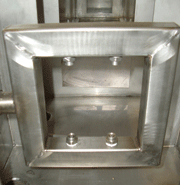
After cleaning, the stamping strip is fed through a rinsing zone where it
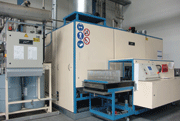
The V2 solvent system for cleaning synchronizer rings is operated under full vacuum. A residual distillation unit next to the system continuously removes carried-over oil from the cleaning agent.
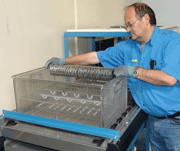
The synchronizer rings are placed into the washing basket on conveyor rods.
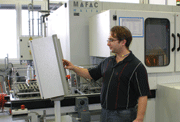
The scrap rate was significantly reduced thanks to the aqueous cleaning system with three media tanks in the castings production department. The system is equipped with automatic loading.
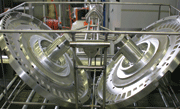
The valve manifolds, oil feed flanges, duct blocks and valve banks are secured in special loading systems which have been specially fabricated for the individual parts.
How can the cleaning task and the cleaning process be ideally matched to one another? With which kind of process can the parts cleaning process be made more reliable and efficient? Which cleaning agents are suitable for which tasks? Answers to these and other questions covering all aspects of industrial parts cleaning are provided at parts2clean. The leading international trade fair for cleaning within the production process and maintenance will take place at the new exhibition centre directly adjacent to Stuttgart International Airport from the 20th through the 22nd of October, 2009. For the first time, an international congress will also be held within the framework of parts2clean 2009 in keeping with the motto, “Worldwide Requirements, Technologies and Markets” on the 19th and 20th of October. www.parts2clean.com and www.parts2clean-congress.com.
Exploiting Potential for Cost and Quality Optimised Processes Parts cleaning is not exempt from the ever more exacting demands being placed upon component quality. A cleaning concept with a requirements oriented layout not only makes it possible to economically fulfil stricter cleanliness specifications. It frequently allows for the exploitation of optimisation potential throughout the entire production sequence, as well as more efficient and environmentally friendly manufacturing.
Where cleanliness is concerned, a genuine tightrope walk has taken place in recent years. Today, it’s no longer adequate for components to be clean “on the surface”. Processing residues such as oils and emulsions, dust, burrs and chips, as well as fingerprints and spots, must be removed in a virtually residue-free fashion. There’s no single answer to the question of which cleaning solution works best in this respect. Modern cleaning systems which are ideally matched to the material, part shape, type and degree of contamination, as well as the specified cleaning requirements and production throughput, are efficient and reliable.
Non-Stop Cleaning and Blasting
Initially, only the blasting solution for the removal of welding splatter and flitter from a stamped part with welded-on brass inserts was taken into consideration. An exact examination of the previously discontinuous production process led to the development of a combination solution which unites ultrasonic cleaning and flow-through blasting at HGH GmbH in Lüdenscheid, Germany, which made a continuous manufacturing sequence possible for the customer. The stampings manufacturer has been able to double his capacity as a result – and reduce costs considerably at the same time.
The part is stamped, bent and welded with a progressive compound tool, but remains attached to the stamping strip at one small point. The strip goes from the tool directly to an ultrasonic cleaning system in order to remove stamping grease and particles. The inlet to the cleaning system is equipped with a light barrier curtain which monitors stamping strip dip. Deviations are forwarded to the controller, which accordingly regulates conveyor operation. The stamping strip passes through an ultrasonic bath with a slightly alkaline cleaning agent for degreasing. Ultrasonic treatment assures that even very fine particulate contamination is removed as well. The strip is blasted with filtered ambient air upstream from the rinsing zone. This minimises cleaning agent carry-over. Fan-shaped nozzles are used for rinsing, which spray water onto the strip from above and below at a pressure of 1.5 bar. After pre-drying with filtered ambient air, the strip is fully dried with hot air at a temperature of roughly 200° C. All of the blasting registers are fed by a side channel blower which compresses ambient air to 0.5 bar.
After cleaning, the strip is automatically advanced to a lapping-blasting system where welding spatter and flitter are removed. Ideal positioning at a constant distance from the individually adjustable blasting jets, which blast the strip at both top and bottom, is assured by a guide. The specially developed blasting medium is accelerated with compressed air, and is directed towards the areas on the strip which require processing in a targeted fashion. The blasting medium is purified in a centrifugal separator. A blow-off station is located at the blasting cabin outlet, at which the stamping strip is pre-cleaned before it runs though a second ultrasonic cleaning system in order to remove blasting medium residue. From a process engineering viewpoint, the setup of this cleaning system is identical to that of the first one.
After the parts have been measured and inspected on the strip, they’re then separated. The conveyor speed for this solution consisting of ultrasonic cleaning, blasting and repeated ultrasonic cleaning is 12 metres per minute.
Even Fingerprints Interfere with Gas Nitriding
Hoerbiger Antriebstechnik GmbH produces complete synchromesh mechanisms for transmissions in Schongau, Germany. All of the big automobile manufacturers belong to their customer base. Depending upon the type of vehicle, double or triple cone synchromesh mechanisms are used, which consist of up to ten individual parts. The range of friction linings includes organic, carbon composite and scatter-sinter materials.
The company set up in-house gas nitriding in order to significantly decrease throughput times and reduce capital commitment. The parts have to be absolutely grease-free for this process – even fingerprints cause problems. Due to these extreme parts cleaning requirements, Hoerbiger conducted numerous cleaning trials with systems from various manufacturers. An order was finally placed for a V2 cleaning system from Pero. Decisive for this decision was the fact that the compact solvent system from the manufacturer in Königsbrunn, Germany, offers good value for the money and 100% proof of cleanliness. And this even holds true when cleaning scatter-sinter friction linings which demonstrate minimal wear, as well as good controllability and outstanding friction coefficients with the heat storage capacity of metallic materials and above average water holding capacity. The latter factor has proven itself a considerable disadvantage for degreasing. Due to the fact that the synchronizer rings are sintered before forming, they also come into contact with highly viscous drawing oil, which must be removed. But the synchronizer rings not only have to be absolutely grease-free for nitro-carburising, they also have to be completely dry.
One of the reasons for the good cleaning performance is the combination of a distillation unit and a residual distillation unit. The cleaning agent is continuously distilled in these two modules, and carried-over oil is removed from the system immediately. Particulate contamination is separated by means of filtration systems, through which the cleaning agent is directed upon flowing from the parts. In order to play it safe, Hoerbiger has additionally equipped the system with a post-rinsing unit. This allows for a second cleaning operation with cleaning agent from a separate tank. Furthermore, an ultrasonic cleaning module was also installed, in order to assure that non-ferrous metal particles from scatter sintering, graphite residues and partial contamination caused by machine oil can be reliably removed.
One of the advantages of the V2 is the ingenious programme structure with freely selectable parts movement during all process steps. This makes it possible for Hoerbiger to create its own cleaning programmes which are matched to the respective task. The synchronizer rings to be degreased have various diameters ranging from 67.5 to 172 mm, but they’re handled with the same conveyor rods. For this reason, each batch rack (washing basket) is equipped with various mounting positions. In this way, each basket (with dimensions of 670 x 480 x 300 mm) can be used for all synchronizer ring sizes.
Residual Contamination Requirements Impressively Fulfilled
Developing and producing innovative products for transportation has been the goal of southern Germany’s Zahnradfabrik (ZF) ever since it was founded in 1915. It all began with the production of gear wheels for gearboxes in Zeppelin airships. Today, ZF is one of the largest internationally active suppliers to the automotive industry in the field of drive and chassis technology. The drive technology division for trucks, railway vehicles and special vehicles is located at corporate headquarters in Friedrichshafen, Germany, which is one of a total of 26 of the company’s worldwide locations. Control components for automatic transmissions used in buses have also been developed here. The engineering department stipulated residual contamination specifications for manufacturing for the first time for its Ecolife product line: The control components have very fine channels which have to be completely free of contamination. In the worst of all cases, contamination could result in blocking of the automatic transmission, which would have disastrous consequences for a bus. A market study was conducted in order to find a cleaning system that would fulfil the specified cleanliness definitions, at the end of which cleaning trials took place with subsequent laboratory evaluation. MAFAC’s MALTA system achieved very good results. The cost-benefit ratio and the compact design of the system from Alpirsbach, Germany, were also convincing.
The MALTA was installed in the castings manufacturing division at ZF, and is currently being used to clean control components for the Ecomat product line. The valve manifolds, oil feed flanges, duct blocks and valve banks have drill-holes and threads with diameters of, for example, 0.9, three, six and 25 millimetres, and are contaminated with oil, emulsion and chips.
The workpieces are cleaned in loading systems which have been specially fabricated for the individual part. This makes it possible to clean all of the parts in question with the process technology developed by MAFAC which turns the loading system in the direction opposite to that of the rotating spray system. High exposure and spraying densities are assured within the system thanks to a combined array of flat-spray nozzles and solid-stream spray nozzles.
The sequence of the three utilised baths is cleaning, rinsing and repeated rinsing. At the moment, two programmes have been stored to the system, whose duration and sequence depends upon the workpieces to be cleaned. A so-called short programme is activated for the oil feed flanges and duct blocks which have relatively few drill-holes, whereas the valve manifolds and valve banks – with many drill-holes – are cleaned with a “long programme”. Scrap rates for the product range in question have been significantly reduced with the MALTA system.
The cleaning bath is equipped with a coalescence separator with surface slurper. Oil and grease are collected in a separate container. Particulate contamination is continuously removed by means of full flow filtration in all baths. Bath service life is roughly four weeks.
For Information:
fairXperts GmbH, Mr. Hartmut Herdin
Hauptstrasse 7, 72639 Neuffen, Germany
Tel. +49.7025 8434-0, Fax 8434-20
E-mail: info@fairxperts.de, www.fairxperts.de



























